In September of 2012, a team of scientists released a photograph showing the most distant parts of the Universe ever seen by any human being. They obtained the photograph by pointing the Hubble Space Telescope at a single tiny patch of sky, gradually building up an image over a total of 23 days of observation. It’s an otherwise undistinguished patch of sky, within the little-known constellation Fornax. It’s less than one hundredth the size of the full moon, and appears totally empty to the naked eye. Here’s what’s seen with the Hubble Telescope:
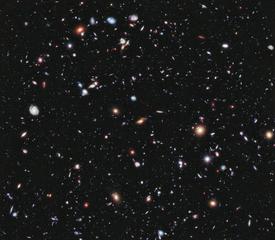
This image is known as the Hubble Extreme Deep Field. It contains 5,500 galaxies, each of which, in turn, contains billions of stars. This region of sky ordinarily looks empty because these galaxies are far too dim to be seen with the naked eye. Some of the galaxies are more than 13 billion light years away. We are seeing them as they were just a few hundred million years after the big bang, near the dawn of time. If you have the eyes to see, this is what deep space and the early history of the universe looks like.
One of the many striking things about the Hubble Extreme Deep Field is that it’s beautiful. Another work revealing beauty in nature is a 1999 art piece by a Dutch-Canadian artist named Juan Geuer. In a darkened room, Geuer shone orange laser light through a single droplet of water, projecting the light onto a wall. The resulting play of light is spectacular. We see the changing internal structure of the droplet, and the interplay of surface tension and gravity, a marvellous mix of refraction, reflection, and diffraction. Here’s a recording of Geuer’s art piece, known as Water in Suspense. (Some browsers don’t start the video at the right moment — move to 13:33 in the recording if that’s the case).
It’s not a typical action-packed online video. It moves slowly, slowly,… and then WHOOSH, a sudden, rapid change. I suggest watching it for at least a minute or two. During that time you’ll start to learn how to watch the droplet. Indeed, getting a feel for the multiple timescales at which the droplet changes is part of what we learn from the work.
Water in Suspense reveals a hidden world. We discover a rich structure immanent in the water droplet, a structure not ordinarily accessible to our senses. In this way it’s similar to the Hubble Extreme Deep Field, which also reveals a hidden world. Both are examples of what I call Super-realist art, art which doesn’t just capture what we can see directly with our eyes or hear with our ears, but which uses new sensors and methods of visualization to reveal a world that we cannot directly perceive. It’s art being used to reveal science.
Although I’m not an artist or an art critic, I find Super-realist art fascinating. Works like the Hubble Extreme Deep Field and Water in Suspense give us concrete, vivid representations of deep space and the interior structure of a water droplet. For most of us, these are usually little more than dry abstractions, remote from our understanding. By creating vivid representations, Super-realist art provides us with a new way of thinking about such phenomena. And so in this essay I explore Super-realist art: what it is, how it relates to other modes of art, and why it is flourishing today.
I’m a technologist and scientist, a person whose main interests are in areas such as machine learning, data science, and, especially, the development of cognitive tools (i.e., tools to extend human thought). It may seem strange that I’m writing an essay about art. But thinking about technology from this viewpoint gives a perspective that’s radically different to the usual take. It’s a flip side, an artistic perspective that sees technology and, in particular, Super-realism, as a means to discover new aesthetics and new representations of reality. That means Super-realism is not just of interest to artists, but can also inform technologists and scientists, giving them a new way of thinking about how we can develop tools that extend human thought.
In discussing Super-realism I will ignore many of the usual labels we use to understand art. Instead, I’ll develop a caricature which divides much of Western art into just three categories: Realism, Post-realism, and Super-realism. I believe this way of thinking illuminates Super-realism, and ask the indulgence of any experts on art history who happen to be reading.
Until the latter part of the 19th century Realism was one of the main aspirations of much Western art [1]. Realist art aimed at capturing the reality accessible to our senses. My favourite Realist artist is Rembrandt:
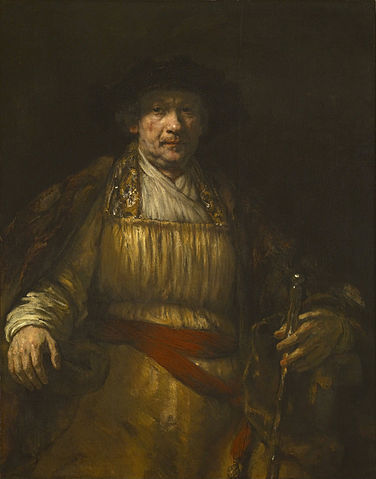 (credit)
(credit)Such paintings seem so true-to-life that it is as though the artist has captured an element of objective reality. Suppose aliens visited Earth after a cataclysm wiped out all traces of humanity, except for a few Rembrandt self-portraits that somehow survived. I believe the aliens could understand much about both Rembrandt and humanity from those portraits, including perhaps even something of Rembrandt’s personality, his habits, his likes, and his dislikes.
But even the most talented Realist artists capture only a tiny slice of reality. Rembrandt’s self-portraits, as real as they appear, omit nearly all the biological and mental processes going on in Rembrandt’s body and mind. Suppose, for example, we could zoom in on his face, seeing it at 10 times magnification, then 100, then 1,000, and so on. At each level of magnification a new world would be revealed, of pores and cells and microbes. And there is so much structure to understand in each of these worlds, from the incredibly complex ecology of microbes on the skin, to the inner workings of cells. Consider this video simulating the inside of a cell:
This is not to criticise Rembrandt and the other Realists. On their own terms, they succeeded. But what Super-realism shows is that we can see far deeper into the world, and find great beauty in so doing.
In the 20th century Western art moved away from Realism, and Post-realist art became increasingly influential. To describe how Super-realism relates to Post-realism I’ll use the work of Monet. Monet was an early Post-realist painter, one working at the boundary between Realism and Post-realism. Here’s one of Monet’s great works, the "Water Lillies" tryptych, housed in the Museum of Modern Art in New York:
Unfortunately, when viewed on a computer screen or as a small print, this tryptych looks washed out and insipid, a poor imitation of the Realists. But when you see the original — 6 and a half feet high, and 42 feet long — the effect is jaw-dropping. Monet’s genius, and what made his painting so overwhelming, was a deep understanding of how humans see. He was a master illusionist who understood how to trick the viewer’s brain into seeing something much, much better than a realistic rendition. This only works at scale. When "Water Lillies" is shrunk to print size, the psychology of perception changes, and the illusion vanishes. I don’t understand why this is. I’ve read something of the theory of Monet and his fellow Impressionists, and don’t find those explanations convincing. What I do know is that Monet’s shimmering pond loses its glory. It looks fake, less than a literal rendition, merely a washed out print. But somehow, in the original, Monet was able to use his understanding of human perception to evoke water lillies in a fashion more spectacular than a Realist painting could ever have achieved.
In Post-realism, art isn’t about directly representing an objective, independent reality. Instead, it’s about creating new types of relationship between the art piece and the human mind. Monet and his fellow Impressionists were on the boundary between Realism and Post-Realism, since their works still aimed to evoke an objective, independent reality, albeit not by a direct representation. But Post-realism was pushed much further by later artists, such as Picasso, M. C. Escher, and Kandinsky:
 (credit)
(credit) 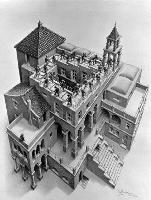 (credit)
(credit) 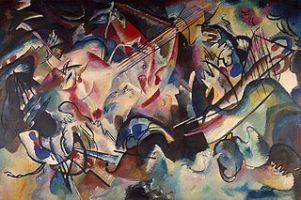 (credit)
(credit)These works gradually shift away from representing reality, and toward exploring the relationship between art piece and viewer. Escher, for example, used quirks in the human visual system to evoke impossible realities. Abstract artists such as Kandinsky take this idea still further, and it is developed to an extreme in the work of abstract minimalists such as John McLaughlin, a pioneer in what is known as Hard-edge painting:
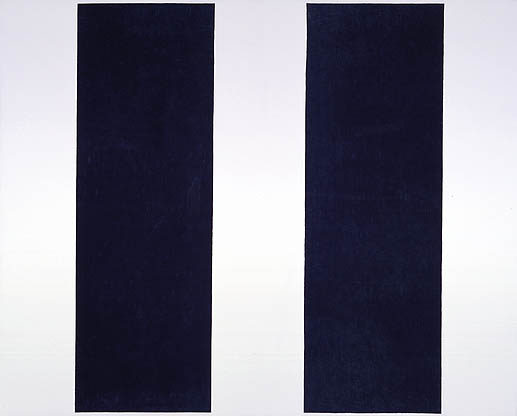 (credit)
(credit)At first glance this (and much of McLaughlin’s other work) looks ludicrous. But it makes more sense when you understand that McLaughlin was exploring how people respond to art. His earlier works were more complex. But he gradually simplified his work as he realized that people can have novel responses even to simple stimuli.
Abstract minimalism annoys many people. The approach can and has led to fakery and foolishness on the part of some artists. But my point here is neither to criticise nor to praise. Instead, it’s to understand what artists such as McLaughlin were up to. Whereas the Realist artists believed that virtuosity came from depicting part of reality with high fidelity, in Post-realism virtuosity may come from creating a novel relationship between art piece and viewer.
Super-realism changes art again. Virtuosity becomes about revealing hidden worlds and discovering new aesthetics. Take a look at the following video, which shows — in extreme slow motion! — a packet of light passing through a bottle. Ordinarily that passage takes less than a nanosecond, but the video slows the passage down by a factor of 10 billion, so we can see it:
In a way, Super-realism is a return to the aims of Realism, back to representing reality. But what’s new about Super-realism is the challenge (and opportunity!) to find ways of representing previously unseen parts of the world.
Most of my examples of Super-realist art have come from people who regard themselves mainly as scientists, not as artists. However, there are many artists doing Super-realist art. I’ve drawn my examples mostly from scientists merely because I’ve found that artists’ work is often more exploratory, and thus requires more background explanation, making it less suited for an essay such as this.
Although Super-realism’s flourishing is recent, its origins go back centuries. In 1610, Galileo published a short book entitled Starry Messenger (Sidereus Nuncius), which contained several images showing the moon in unprecedented detail, as observed by Galileo through one of his new telescopes:
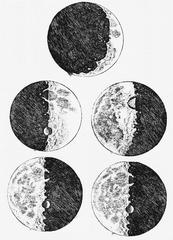 (credit)
(credit)In a similar vein, in 1665 Robert Hooke published a bestselling book entitled Micrographia, which used the newly-invented microscope to reveal the world of the very small. Hooke’s book included the first ever drawings of biological cells, as well as drawings showing animals such as fleas in unprecedented detail:

While Super-realism isn’t new, that doesn’t mean it’s yet in the artistic mainstream. Many people don’t consider works such as the Hubble Extreme Deep Field or the light-in-a-bottle video to be art. (I would not be surprised if this includes the creators of those works.) Even works more explicitly artistic in intent, such as Water in Suspense, are viewed as borderline. But I believe that each of these works reveals a new aesthetic, an aesthetic generated by the scientific principles underlying the phenomenon being represented. And insofar as they reveal a new aesthetic, I believe these works are art.
Although Super-realism isn’t yet in the artistic mainstream, it has influenced parts of that mainstream. For example, in the 1980s the film diector and cinematographer Ron Fricke used time-lapse photography to reveal new aspects of the everyday world, in documentary films such as Chronos [2]:
Fricke was not, of course, the first to use time-lapse photography in this way. However, his films have won wide acclaim, and inspired many other artists to develop time-lapse photography further as an artistic medium.
Super-realism has grown rapidly in the past twenty to thirty years. Three forces are driving that growth.
First, far more people can access and learn to use scientific instruments. Recall Juan Geuer and his virtuoso home-made laser light show. There are people building everything from home-made bubble chambers to balloons exploring the upper atmosphere. These are not isolated curiosities, but rather part of a rapidly expanding social phenomenon that has been called by many names: the DIY movement, citizen science, the Maker movement. Whatever it is, it’s growing, fed by the expansion of online and mail-order suppliers that serve niche markets, and by the growth of online (and, increasingly, offline) communities of people who work with these instruments and teach one another.
Second, the data being taken by many of these instruments is being shared openly, online. In the 1980s if a scientist used a telescope to take a photograph, likely no more than a few dozen people would ever touch the photographic plate. Now more than a billion people can download data from the Hubble Telescope, and find new ways to visualize it. Some of the most extraordinary visualizations of the Earth are made using data released openly by NASA. Any scientific project which releases data enables others to find new ways of making meaning from that data.
Third, we’re collectively building a powerful suite of tools to reveal these new worlds. For example, as I write there are more than 25,000 open source visualization projects available on the code repository GitHub. Most of those projects are, of coure, experiments that will be abandoned. But there are also many powerful tools that give people incredible abilities to make and reveal beauty. It’s no wonder Super-realism is flowering.
Story-tellers say that reality is often stranger and more interesting than fiction. I believe this is true for all art. The reason is that nature is more imaginative than we, and as we probe deeper into nature, we will continue to discover new aesthetics and new forms of beauty. I believe these new aesthetics will stimulate art for decades or centuries to come.
If you enjoyed this essay, you may wish to subscribe to my blog, or follow me on Twitter.
Footnotes
[1] I am referring to Realist art broadly, not the 19th century artistic movement known as Realism. I’m also certainly not claiming that all Western art was Realist until the late 19th century, merely that the idea of representing objective reality was often deeply influential.
[2] The YouTube video shows images from Chronos, but the music is from another source. Unfortunately, I could not find a good unabridged excerpt from Chronos online.
Acknowledgements: This essay arose out of many conversations with Jen Dodd, especially about her work with the Subtle Technologies Festival of Art and Science. Thanks also to Miriah Meyer and Lee Smolin for conversations that helped stimulate this essay.
